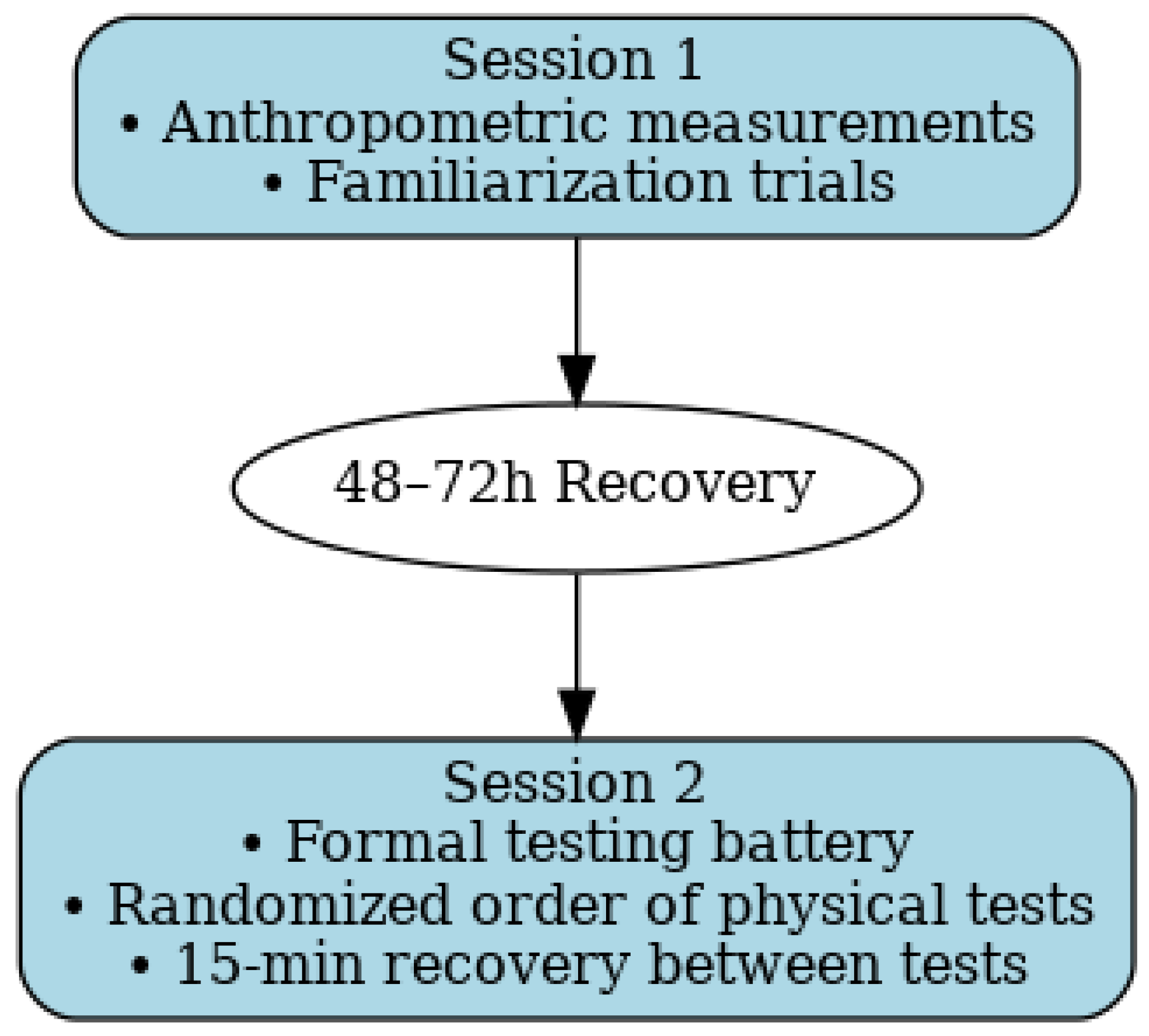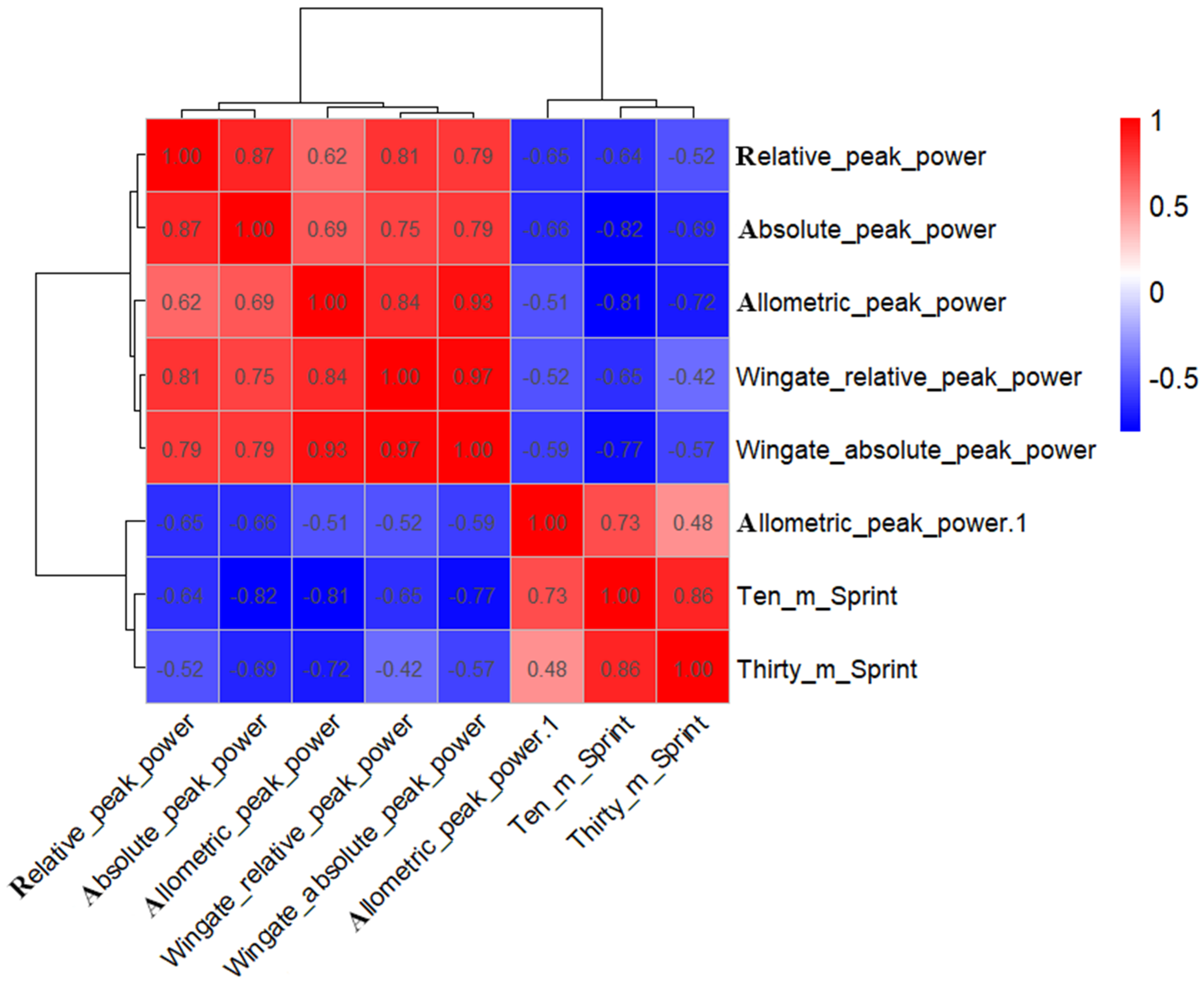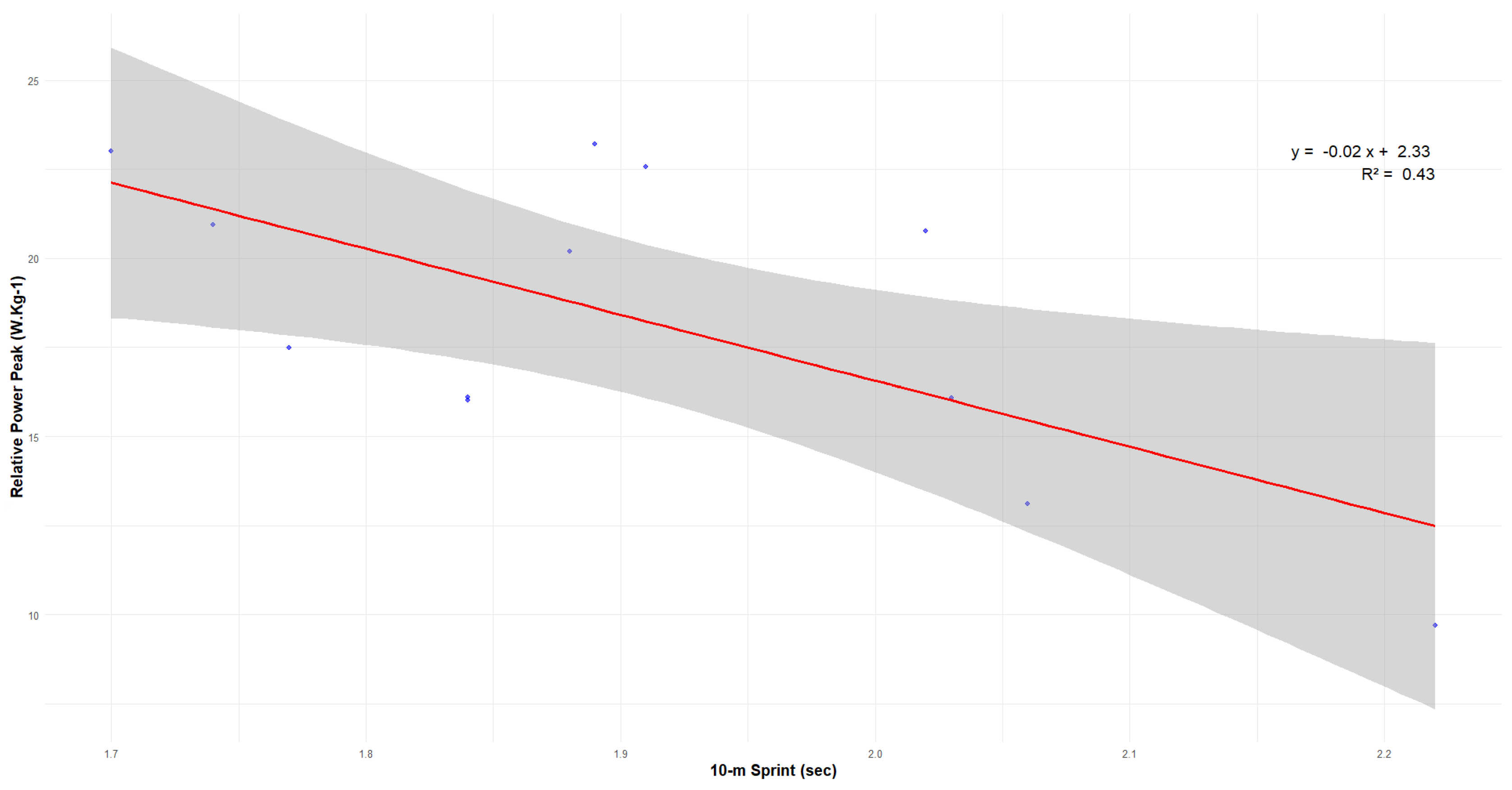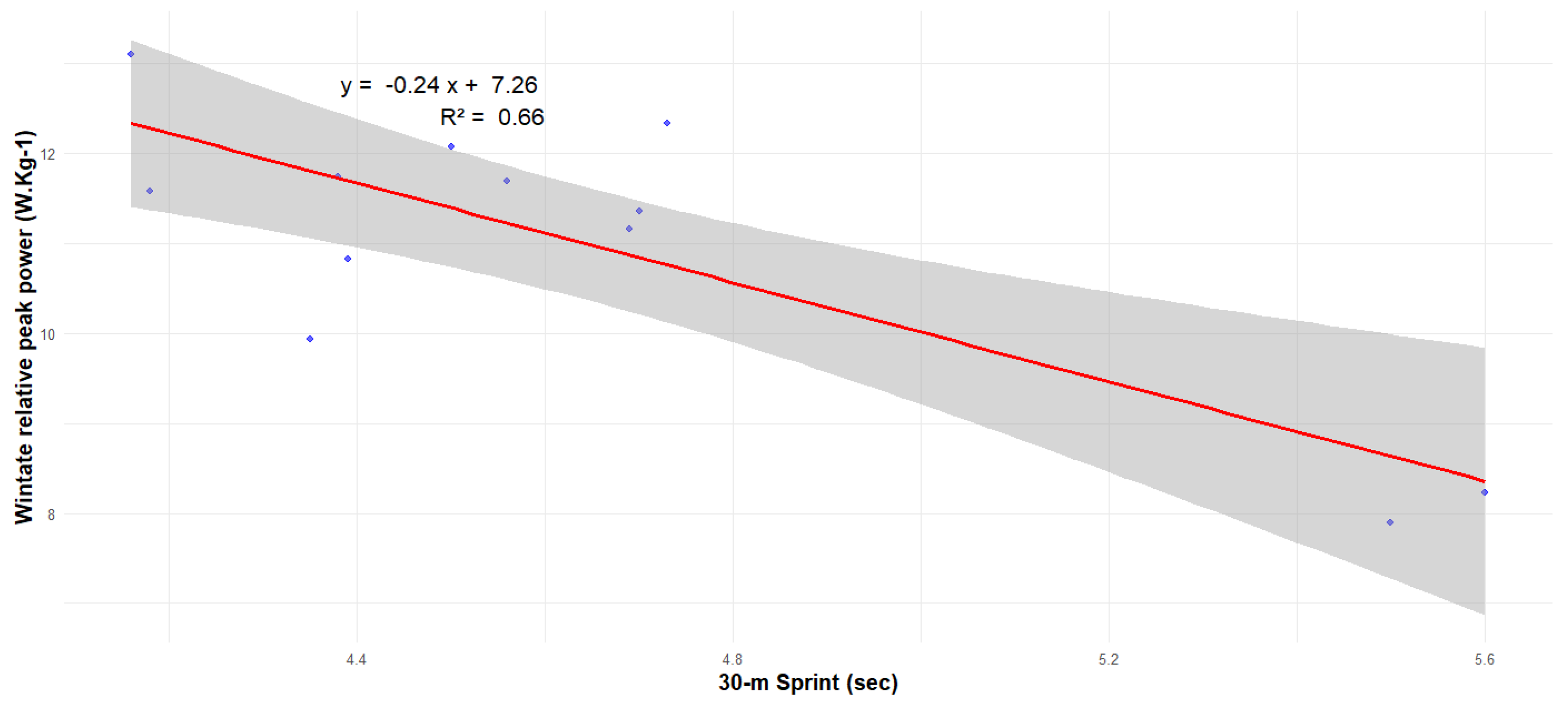Concurrent Validity of the Optojump Infrared Photocell System in Lower Limb Peak Power Assessment: Comparative Analysis with the Wingate Anaerobic Test and Sprint Performance
Abstract
1. Introduction
2. Methods
2.1. Study Design
2.2. Participants
2.3. Experimental Procedures
2.3.1. Pre-Testing Preparation
2.3.2. Anthropometric Measurements
2.3.3. Physical Performance Testing
2.4. Statistical Analysis
3. Results
3.1. Participant Characteristics
3.2. Performance Outcomes and Between-Method Comparisons
3.3. Correlation Analysis and Construct Validity
3.4. Predictive Relationships and Variance Explanation
4. Discussion
4.1. Study Limitations
4.2. Future Research Directions and Clinical Applications
5. Conclusions
Author Contributions
Funding
Institutional Review Board Statement
Data Availability Statement
Acknowledgments
Conflicts of Interest
References
- He, J.; Li, M.; Zhang, Q.; Zhang, Z. Associations between the performance of vertical jump and accelerative sprint in elite sprinters. Front. Bioeng. Biotechnol. 2025, 13, 1539197. [Google Scholar] [CrossRef]
- Dhahbi, W. Advancing biomechanics: Enhancing sports performance, mitigating injury risks, and optimizing athlete rehabilitation. Front. Sports Act. Living 2025, 7, 1556024. [Google Scholar] [CrossRef]
- Söyler, M.; Zileli, R.; Çingöz, Y.E.; Kılınçarslan, G.; Kayantaş, İ.; Altuğ, T.; Asan, S.; Şahin, M.; Gürkan, A.C. The effect of high-intensity plyometric training on anaerobic performance parameters: A pilot study in U17 elite A league. PeerJ 2024, 12, e16648. [Google Scholar] [CrossRef] [PubMed]
- Johnson, P.C. Comparison of a Four 40-Yard Sprint Test for Anaerobic Capacity in Males vs. the Wingate Anaerobic Test. Master’s Thesis, Georgia Southern University, Statesboro, GA, USA, 2007. Available online: https://digitalcommons.georgiasouthern.edu/etd/77 (accessed on 26 August 2025).
- Sands, W.A.; McNeal, J.R.; Ochi, M.T.; Urbanek, T.L.; Jemni, M.; Stone, M.H. Comparison of the Wingate and Bosco anaerobic tests. J. Strength Cond. Res. 2004, 18, 810–815. [Google Scholar] [PubMed]
- Vandewalle, H.; Peres, G.; Heller, J.; Panel, J.; Monod, H. Force-velocity relationship and maximal power on a cycle ergometer: Correlation with the height of a vertical jump. Eur. J. Appl. Physiol. Occup. Physiol. 1987, 56, 650–656. [Google Scholar] [CrossRef]
- Dhahbi, W.; Chaabene, H.; Pyne, D.B.; Chamari, K. Standardizing the quantification of external load across different training modalities: A critical need in sport-science research. Int. J. Sports Physiol. Perform. 2024, 19, 1173–1175. [Google Scholar] [CrossRef]
- Cometti, G.; Maffiuletti, N.; Pousson, M.; Chatard, J.-C.; Maffulli, N. Isokinetic strength and anaerobic power of elite, subelite and amateur French soccer players. Int. J. Sports Med. 2001, 22, 45–51. [Google Scholar] [CrossRef]
- Carlock, J.M.; Smith, S.L.; Hartman, M.J.; Morris, R.T.; Ciroslan, D.A.; Pierce, K.C.; Newton, R.U.; Harman, E.A.; Sands, W.A.; Stone, M.H. The relationship between vertical jump power estimates and weightlifting ability: A field-test approach. J. Strength Cond. Res. 2004, 18, 534–539. [Google Scholar] [PubMed]
- Liu, Y.; Yan, J.; Gong, Z.; Liu, Q. The impact of the Wingate test on anaerobic power in the lower limbs of athletes with varied duration and load. Front. Physiol. 2025, 16, 1582875. [Google Scholar] [CrossRef]
- Zupan, M.F.; Arata, A.W.; Dawson, L.H.; Wile, A.L.; Payn, T.L.; Hannon, M.E. Wingate anaerobic test peak power and anaerobic capacity classifications for men and women intercollegiate athletes. J. Strength Cond. Res. 2009, 23, 2598–2604. [Google Scholar] [CrossRef]
- Attia, A.; Dhahbi, W.; Chaouachi, A.; Padulo, J.; Wong, D.; Chamari, K. Measurement errors when estimating the vertical jump height with flight time using photocell devices: The example of Optojump. Biol. Sport 2017, 34, 63–70. [Google Scholar] [CrossRef]
- Atik, B.; Badilli, F.S. Is there any correlation between anaerobic performance and vertical jump height in female volleyball athletes? J. Bodyw. Mov. Ther. 2024, 40, 11–15. [Google Scholar] [CrossRef]
- Çetin, O.; Kaya, S.; Atasever, G.; Akyildiz, Z. The validity and reliability of the jump power app for measuring vertical jump actions in professional soccer players. Sci. Rep. 2024, 14, 28801. [Google Scholar] [CrossRef]
- Gross, M.; Lüthy, F. Anaerobic power assessment in athletes: Are cycling and vertical jump tests interchangeable? Sports 2020, 8, 60. [Google Scholar] [CrossRef]
- Küçükkubaş, N.; Günay, A.; Löklüoğlu, B.; Kakil, B. Relationship between body composition, vertical jump, 30 M sprint, static strength and anaerobic power for athletes. Int. J. Sport Exerc. Train. Sci.-IJSETS 2019, 5, 68–78. [Google Scholar] [CrossRef]
- Stewart, A.; Marfell-Jones, M.; Olds, T.; De Ridder, H. International Standards for Anthropometric Assessment; International Society for Advancement of Kinanthropometry (ISAK): Lower Hutt, New Zealand, 2011; Volume 125. [Google Scholar]
- Durnin, J.V.; Womersley, J. Body fat assessed from total body density and its estimation from skinfold thickness: Measurements on 481 men and women aged from 16 to 72 years. Br. J. Nutr. 1974, 32, 77–97. [Google Scholar] [CrossRef] [PubMed]
- Dotan, R.; Bar-Or, O. Load optimization for the Wingate anaerobic test. Eur. J. Appl. Physiol. Occup. Physiol. 1983, 51, 409–417. [Google Scholar] [CrossRef]
- Glatthorn, J.F.; Gouge, S.; Nussbaumer, S.; Stauffacher, S.; Impellizzeri, F.M.; Maffiuletti, N.A. Validity and reliability of Optojump photoelectric cells for estimating vertical jump height. J. Strength Cond. Res. 2011, 25, 556–560. [Google Scholar] [CrossRef] [PubMed]
- Castagna, C.; Castellini, E. Vertical jump performance in Italian male and female national team soccer players. J. Strength Cond. Res. 2013, 27, 1156–1161. [Google Scholar] [CrossRef]
- Negra, Y.; Chaabene, H.; Sammoud, S.; Prieske, O.; Moran, J.; Ramirez-Campillo, R.; Nejmaoui, A.; Granacher, U. The increased effectiveness of loaded versus unloaded plyometric jump training in improving muscle power, speed, change of direction, and kicking-distance performance in prepubertal male soccer players. Int. J. Sports Physiol. Perform. 2020, 15, 189–195. [Google Scholar] [CrossRef]
- Hopkins, W.; Marshall, S.; Batterham, A.; Hanin, J. Progressive statistics for studies in sports medicine and exercise science. Med.+ Sci. Sports+ Exerc. 2009, 41, 3. [Google Scholar] [CrossRef]
- Bull, F.C.; Al-Ansari, S.S.; Biddle, S.; Borodulin, K.; Buman, M.P.; Cardon, G.; Carty, C.; Chaput, J.-P.; Chastin, S.; Chou, R. World Health Organization 2020 guidelines on physical activity and sedentary behaviour. Br. J. Sports Med. 2020, 54, 1451–1462. [Google Scholar] [CrossRef] [PubMed]
- Kaufmann, S.; Hoos, O.; Beck, A.; Fueller, F.; Latzel, R.; Beneke, R. The metabolic relevance of type of locomotion in anaerobic testing: Bosco continuous jumping test versus Wingate anaerobic test of the same duration. Int. J. Sports Physiol. Perform. 2021, 16, 1663–1669. [Google Scholar] [CrossRef]
- Chelly, M.S.; Hermassi, S.; Shephard, R.J. Relationships between power and strength of the upper and lower limb muscles and throwing velocity in male handball players. J. Strength Cond. Res. 2010, 24, 1480–1487. [Google Scholar] [CrossRef] [PubMed]
- Dhahbi, W.; Hachana, Y.; Souaifi, M.; Souidi, S.; Attia, A. Tennis-specific incremental aerobic test (TSIAT): Construct validity, inter session reliability and sensitivity. Tunis. J. Sports Sci. Med. 2024, 2, 25–32. [Google Scholar] [CrossRef]
- Čular, D.; Dhahbi, W.; Kolak, I.; Iacono, A.D.; Bešlija, T.; Laffaye, G.; Padulo, J. Reliability, sensitivity, and minimal detectable change of a new specific climbing test for assessing asymmetry in reach technique. J. Strength Cond. Res. 2021, 35, 527–534. [Google Scholar] [CrossRef]
- Čular, D.; Ivančev, V.; Zagatto, A.M.; Milić, M.; Beslija, T.; Sellami, M.; Padulo, J. Validity and reliability of the 30-s continuous jump for anaerobic power and capacity assessment in combat sport. Front. Physiol. 2018, 9, 543. [Google Scholar] [CrossRef] [PubMed]





| Mean | SD | Min | Max | |
|---|---|---|---|---|
| Age (years) | 23.39 | 1.47 | 22.15 | 27.00 |
| Height (cm) | 173.67 | 6.97 | 160.00 | 184.00 |
| Body mass (kg) | 73.08 | 9.19 | 59.80 | 91.20 |
| %Body Fat (%) | 17.80 | 3.90 | 13.18 | 24.53 |
| BMI (kg·m−2) | 24.17 | 1.48 | 21.74 | 26.94 |
| Components of Physical Fitness | Participants (n = 12) |
|---|---|
| Sprint test | |
| 10 m (s) | 1.91 ± 0.15 |
| 30 m (s) | 4.65 ± 0.46 |
| 15 s anaerobic Wingate test | |
| Relative peak power (W·kg−1) | 10.99 ± 1.58 |
| Absolute peak power (W) | 807.28 ± 175.45 |
| Allometric peak power (W·kg−0.67) | 93.26 ± 15.94 |
| 30 s continuous jumping | |
| Relative peak power (W·kg−1) | 18.263 ± 4.24 |
| Absolute peak power (W) | 1387.15 ± 422.23 |
| Allometric peak power (W·kg−0.67) | 155.131 ± 38.35 |
| Mean Difference ± SD | Effect Size | CI95 | t | p | |
|---|---|---|---|---|---|
| Relative peak power—Wingate relative peak power W·kg−1 | 7.27 ± 3.43 | 2.12 | 1.06 to 3.14 | 7.33 | <0.001 |
| Absolute peak power—Wingate absolute peak power W | 579.87 ± 298.40 | 1.94 | 0.95 to 2.90 | 6.73 | <0.001 |
| Allometric expression—Wingate allometric expression W·kg−0.67 | 61.87 ± 27.58 | 2.24 | 1.15 to 3.31 | 7.77 | <0.001 |
Disclaimer/Publisher’s Note: The statements, opinions and data contained in all publications are solely those of the individual author(s) and contributor(s) and not of MDPI and/or the editor(s). MDPI and/or the editor(s) disclaim responsibility for any injury to people or property resulting from any ideas, methods, instructions or products referred to in the content. |
© 2025 by the authors. Licensee MDPI, Basel, Switzerland. This article is an open access article distributed under the terms and conditions of the Creative Commons Attribution (CC BY) license (https://creativecommons.org/licenses/by/4.0/).
Share and Cite
Khemiri, A.; Negra, Y.; Ceylan, H.İ.; Hajri, M.; Njah, A.; Hachana, Y.; Yıldız, M.; Bayrakdaroğlu, S.; Muntean, R.I.; Attia, A. Concurrent Validity of the Optojump Infrared Photocell System in Lower Limb Peak Power Assessment: Comparative Analysis with the Wingate Anaerobic Test and Sprint Performance. Appl. Sci. 2025, 15, 10741. https://doi.org/10.3390/app151910741
Khemiri A, Negra Y, Ceylan Hİ, Hajri M, Njah A, Hachana Y, Yıldız M, Bayrakdaroğlu S, Muntean RI, Attia A. Concurrent Validity of the Optojump Infrared Photocell System in Lower Limb Peak Power Assessment: Comparative Analysis with the Wingate Anaerobic Test and Sprint Performance. Applied Sciences. 2025; 15(19):10741. https://doi.org/10.3390/app151910741
Chicago/Turabian StyleKhemiri, Aymen, Yassine Negra, Halil İbrahim Ceylan, Manel Hajri, Abdelmonom Njah, Younes Hachana, Mevlüt Yıldız, Serdar Bayrakdaroğlu, Raul Ioan Muntean, and Ahmed Attia. 2025. "Concurrent Validity of the Optojump Infrared Photocell System in Lower Limb Peak Power Assessment: Comparative Analysis with the Wingate Anaerobic Test and Sprint Performance" Applied Sciences 15, no. 19: 10741. https://doi.org/10.3390/app151910741
APA StyleKhemiri, A., Negra, Y., Ceylan, H. İ., Hajri, M., Njah, A., Hachana, Y., Yıldız, M., Bayrakdaroğlu, S., Muntean, R. I., & Attia, A. (2025). Concurrent Validity of the Optojump Infrared Photocell System in Lower Limb Peak Power Assessment: Comparative Analysis with the Wingate Anaerobic Test and Sprint Performance. Applied Sciences, 15(19), 10741. https://doi.org/10.3390/app151910741








